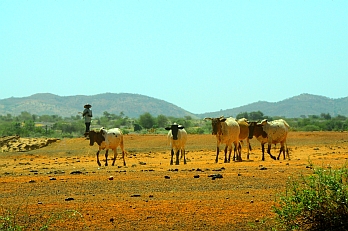The theme of the 2013 World Day to Combat Desertification and Drought is drought and water scarcity. Don’t let our future dry up!
In the open plateaus of Burkina Faso the Volta rises from the union of the Black, White and Red Voltas, twisting its way southward through Ghana and eventually discharging in the Gulf of Guinea.

Like many other rivers the Volta has a long history of service to the population of its river banks. With continuous settlements of farmers and fishermen from ancient times to present, today more than ever the Volta plays a critical role for the people and economy of West Africa. Its’ water is the lifeline for agriculture. Livestock, fisheries, recreation and electricity production depend on the water of this mighty river that is also recharging one of the largest artificial reservoirs in the world. Overall it is estimated that the Ghana basin systems alone hold almost 40million m3 surface water available.
With this much water the myth was created that it will be almost impossible for the country to be short on water. However, the severe droughts of the past, which dried up most of the surface water, resulting in shortages in food production, famine and decline in human livelihood, might provide a lesson that after all there could be a shortage of water even in the midst of plenty. And with pressures such as population growth and climate change the demand of water increases, putting the role of water management to prevent droughts under scrutiny.
Decreasing rainfall, increasing temperatures
As part of the Project: Re-thinking Water Storage for Climate Change Adaptation in Sub-Saharan Africa, researchers from the International Water Management Institute (IWMI) attempted to assess historical trends in rainfall patterns and to measure the impact of climate change on flows in the Volta. The researchers used climate data simulated for the IPCC A1B scenario to analyze future trends for the hydrological cycle in the Volta region.
“We used the IPCC A1B emissions scenario as the basis for our analysis”, says IWMI’s Aditya Sood. “The scenario projects a decrease in rainfall in consistency with an earlier IWMI study conducted by Guillaume Lacombe.” Lacombe’s study concluded that, although no significant changes were observed in annual rainfall, the number of wet season days reduced; a delay in the wet season onset was observed at several locations throughout the region; and wet season rainless periods slightly lengthened in the south and center of Ghana.
For the current study the IPCC A1B scenario was used to run a hydrological model – the Soil and Water Assessment Tool (SWAT), which was calibrated for a number of sub catchments within the basin. The results of the analysis indicate increased variability and a decrease of up to 40% in river flows as a consequence of decreasing rainfall and increasing temperature in the Volta. This will reduce soil moisture and groundwater recharge leading to a higher risk for droughts and consequently affect agriculture and hydroelectric power production.
One solution does not fit all
The study also reveals higher variability in southern catchments of the basin with even greater variability in the latter half of the 21st century, which brought the research team to suggest a watershed-based management approach. “In large river basins such as the Volta, one solution cannot fit the whole basin and there is clearly need for decentralized water resources management”, says Sood.
 IWMI researchers have been exploring the impact of climate change and droughts in the Volta.
IWMI researchers have been exploring the impact of climate change and droughts in the Volta.
The negative impacts of reduced soil moisture and groundwater recharge could be mitigated by more decentralized rainwater harvesting techniques and soil moisture management to store water in the landscape. “Essential to mitigate the impacts of climate change is to consider water storage as a system with a range of options”, says Sood. “Reservoirs, soil moisture and groundwater have each their strengths and weaknesses depending on the circumstances, but with combined different options that complement each other resilience increases. For example, surface-water storage in combination with groundwater is likely to be much more reliable and resilient that surface-water storage alone.”
About the author:
Anna Deinhard is a Communications Fellow at the International Water Management Institute (IWMI). She has a MSc in Environmental Sciences from Linkoping University in Sweden, with a specialization in water and development.

